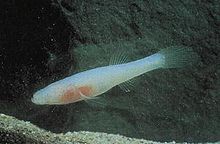The northern cavefish or northern blindfish is found in caves through Kentucky and southern Indiana. The International Union for Conservation of Nature lists the species as near threatened.

The Amblyopsidae are a fish family commonly referred to as cavefish, blindfish, or swampfish. They are small freshwater fish found in the dark environments of caves, springs and swamps in the eastern half of the United States. Like other troglobites, most amblyopsids exhibit adaptations to these dark environments, including the lack of functional eyes and the absence of pigmentation. More than 200 species of cavefishes are known, but only six of these are in the family Amblyopsidae. One of these, Forbesichthys agassizii, spends time both underground and aboveground. A seventh species in this family, Chologaster cornuta, is not a cave-dweller but lives in aboveground swamps.
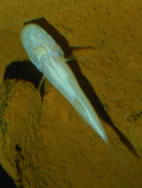
The Alabama cavefish is a critically endangered species of amblyopsid cavefish found only in underground pools in Key Cave, located in northwestern Alabama, United States in the Key Cave National Wildlife Refuge. It was discovered underneath a colony of gray bats in 1967 by researchers Robert A. Kuehne and John E. Cooper and scientifically described in 1974.
The Ozark Cavefish National Wildlife Refuge is a 40-acre (16-ha) National Wildlife Refuge located in Lawrence County, Missouri, 20 mi (32 km) west of Springfield. The United States Fish and Wildlife Service acquired the land in 1991 to protect the endangered Ozark cavefish.
The spring cavefish is the only member of the genus Forbesichthys and is one of seven species in the family Amblyopsidae. This species is listed as state endangered in Missouri, but it is considered to be of least concern by the IUCN Red List due to its relatively large population size and number of subpopulations. The spring cavefish inhabits caves, springs, spring runs, and spring seeps. It is subterranean, emerging at dusk and retreating underground an hour or two before dawn. The species is located within areas of the central and southeastern United States. It stays underground after dawn, but then emerges into surface waters at dusk. They are a carnivorous fish and are well adapted to their environment. The species' breeding behavior is rarely documented. Spawning occurs underground and in darkness between January and April. The status and distribution of cave-obligate species is incomplete or lacking entirely, which makes conservation and management decisions difficult. Kentucky and Missouri are the two main states that have their agencies managing this species in some way.

The blind cave eel is a species of cavefish in the family Synbranchidae. It is the longest cavefish in Australia and one of the only three vertebrates in Australia that is restricted to underground waters, the other being the blind gudgeon and the Barrow cave gudgeon. It is blind, its body is eel-like and elongated, and it has a non-pigmented skin with colours ranging from white to pink.
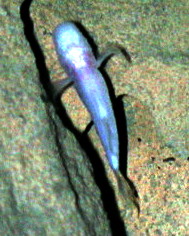
Typhlichthys subterraneus, the southern cavefish, is a species of cavefish in the family Amblyopsidae endemic to karst regions of the eastern United States.
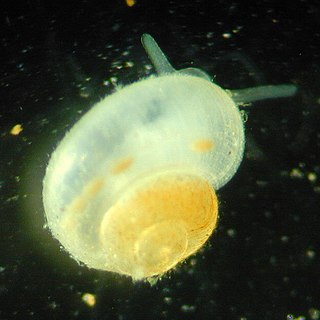
The Tumbling Creek cavesnail is a species of freshwater cave snail with gills and an operculum, an aquatic gastropod mollusk in the family Amnicolidae.
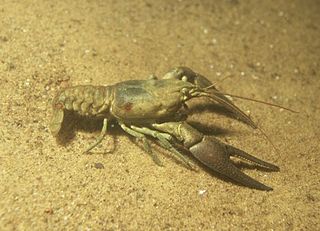
Cambarus aculabrum is a rare species of cave-dwelling crayfish known by the common name Benton county cave crayfish. It is native to Arkansas in the United States, where it is known from only four locations. It is a federally listed endangered species of the United States.
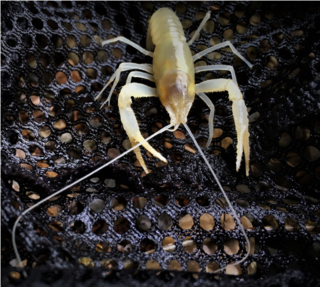
Cambarus zophonastes, also known as the Hell Creek Cave crayfish, is named for its original location of discovery, Hell Creek Cave. It is also found in other similar habitats in Stone County and Marion County, Arkansas. These habitats include springs and caves such as Nesbitt Spring Cave in Stone County. C. zophanastes is critically endangered according to the IUCN. C. zophanastes is also protected by the ESA as an endangered species. Currently conservation efforts focus on monitoring populations, reducing disturbances, and monitoring water quality. More research has to be conducted to better understand and conserve the species.

Cavefish or cave fish is a generic term for fresh and brackish water fish adapted to life in caves and other underground habitats. Related terms are subterranean fish, troglomorphic fish, troglobitic fish, stygobitic fish, phreatic fish, and hypogean fish.
The Neosho National Fish Hatchery is the oldest federal fish hatchery in operation today. It is one of 69 fish hatcheries operated by the US Fish and Wildlife Service. It was established in 1888.

The Ozark big-eared bat is an endangered species found only in a small number of caves in Arkansas, Oklahoma and Missouri, the southern central United States. Also known as the western big-eared bat, the long-eared bat, and the lump-nosed bat, its appearance is defined by a pair of outsize ears and a lump-adorned nose.

Originally known as the Oklahoma Bat Caves National Wildlife Refuge, Ozark Plateau National Wildlife Refuge was established for the protection of endangered bats and their habitat. The refuge is made up of several parcels of land located in northeastern Oklahoma. These parcels contain numerous caves considered crucial for the bats' survival.
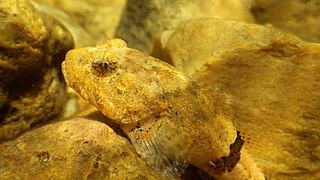
The banded sculpin is a freshwater fish dwelling mostly in small to moderate sized streams in areas of swift current. Young and juvenile C. carolinae can mainly be found in pools, riffles, and other shallow habitats while adults tend to prefer deeper waters. C. carolinae primarily eats insects and insect larvae, but their large mouths enable them to eat prey nearly as large as themselves, including other sculpin. To prevent predation, including by other fish, the color and pattern of the sculpin tends to match its environment. Most Cottus carolinae are mottled brown with dark vertical banding and usually reach about three inches in length. They have a broad head which rather quickly narrows into a slim body, giving them the appearance of a tadpole reaching adulthood.

Amblyopsis is a genus of small fish in the family Amblyopsidae that are endemic to the central and eastern United States. Like other cavefish, they lack pigmentation and are blind. The most recently described species was in 2014. Uniquely among fish, Amblyopsis brood their eggs in the gill chambers. It was formerly incorrectly speculated that the same brooding behavior existed in other genera in the family and in the pirate perch. During the Pleistocene period, the modern Ohio river was a barrier of dispersal and created a great genetic variation, leading to two phylogenetically distinct lineages from the species Amblyopsis.

The Hoosier cavefish is a subterranean species of blind fish from southern Indiana in the United States. Described in 2014, A. hoosieri was the first new species of amblyopsid cavefish to be discovered in 40 years.

Rhadine infernalis is a species of troglobitic beetle of the family Carabidae. They are endemic to the county of Bexar, Texas. Within this county, R. infernalis has been found in 39 caves. There are 2 named subspecies of R. infernalis: R. infernalis infernalis and R. infernalis ewersi. There is a third possible subspecies that has not been officially described. R. infernalis was classified in 2000 as endangered under the IUCN Endangered Species Act of 1973, along with 8 other karst invertebrates in the same region. It has the widest known range of the endangered karst invertebrates.
